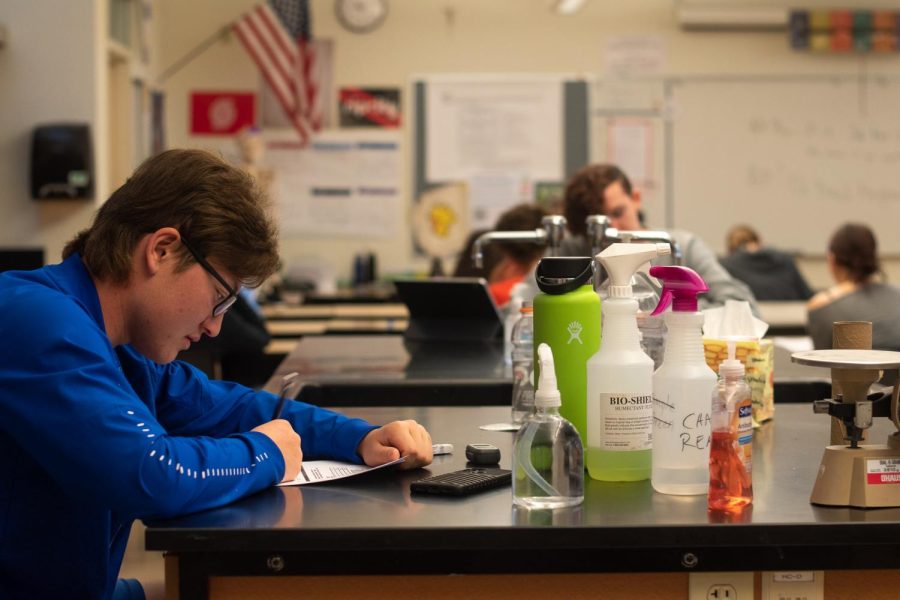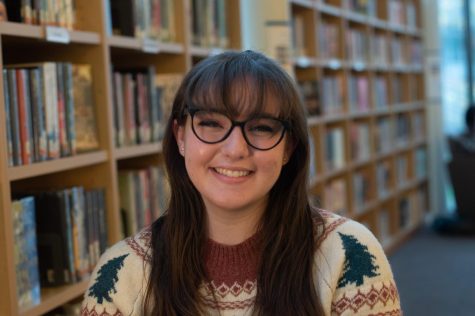Substitute Shortages in the Science Wing Lead Teachers to Work Overtime
Despite the staff shortages in La Salle’s science department this year, “we want to do the best job that we can,” Ms. Coleman said. “At the same time, we only have so much time in the schedule, and that’s what’s getting hard.”
May 11, 2022
The Great Resignation and other impacts of the pandemic have affected various industries across the nation — but for schools, one of its largest impacts has been a lack of substitute teachers.
In May of 2019, an estimated 514,170 substitute teachers were employed in elementary and secondary schools. Since May of 2021, that number has decreased to an estimated 342,610.
For La Salle’s science department, science teachers are covering each other’s classes during some staff members’ extended absences, likely until the end of this school year.
Science teachers Mr. Matthew Owen, Mr. Ryan Kain, Mr. Kyle Voge, Ms. Margaret Ehrich, as well as Design Thinking teacher Ms. Carie Coleman who has a background in teaching science, have all taken on additional science courses this year, according to Vice Principal for Academics Ms. Kathleen Coughran.
“We are grateful for their willingness to take on these additional courses and feel it is the best way to support students to finish the school year,” she said.
The science department has two teachers who will be absent until the end of the year, both of whom were teaching AP science courses. When the science department attempted to get a substitute teacher to fill one of these absences, they only received one applicant, according to Design Thinking teacher Ms. Carie Coleman.
“There’s no one available right now, just like in other industries where it’s hard to find workers with specific skill sets,” Ms. Coleman said. “So what we decided then was, ‘you know what, let’s just divide it up between the teachers we have here at school.’”
The challenge in finding substitute teachers for AP science courses is that there are specific skills required to teach at that caliber, and most people with these skills would opt not to be substitute teachers in favor of higher-paying pursuits, according to Ms. Coleman.
“Market-wise, you’re going to make a lot more money being a biologist and doing other things as opposed to being a teacher, and being a substitute teacher at that, you make even less money,” Ms. Coleman said. “So it takes so much sacrifice to go into that when you have a technical background.”
Because other teachers were already working a sixth-fifths schedule when a new substitute need arose, Mr. Voge and art teacher Ms. Cha Asokan each took on teaching a period of Ms. Coleman’s Introduction to Design Thinking & Tools course, so she would have room to teach four biology classes and one chemistry class, in addition to lesson preparation and grading for her Design Thinking & Tools classes. This means that instead of two prep periods, they have an extra class, giving them only one class period to prepare their lessons.
Despite Ms. Coleman not teaching the Introduction to Design Thinking & Tools classes, she still plans lessons and grades assignments for them. “I’m basically grading seven classes worth of material,” Ms. Coleman said. In addition, Ms. Coleman runs La Salle’s Maker Space before and after school.
Meanwhile, Mr. Kain has taken on the AP Biology courses that were left over, since only he and Ms. Coleman have the correct backgrounds for these courses, according to Ms. Coleman.
Ms. Ehrich has taken on AP Computer Science and Advanced Topics Computer Science.
The science department also consolidated two chemistry classes into one, which Mr. Owen now teaches.
Everyone in the science department is teaching six-fifths, which is considered overtime, according to Ms. Coleman.
“It’s like triage,” Ms. Coleman said. “We have to figure out, ‘what is the most important thing, today, to do? Let’s do that.’”
To Ms. Coleman, the most important thing overall has been “consistency” for students. “That’s what they need right now,” Ms. Coleman said. “That’s the number one thing.”
Ms. Coleman has focused on this consistency in her classes, even if that means filming screencasts or videos for her Design & Thinking classes that she can’t teach herself. “[It’s] not just the teaching part, but just feeling that they’re supported and that there’s someone here to be their advocate and help them learn,” Ms. Coleman said.
In the end, “I don’t get everything done,” Ms. Coleman said. “I try on the weekend to get some stuff done, but I also need time to decompress … We can’t do everything.”
While Ms. Coleman said she understands the situation has not been ideal for students, “the kids have been super patient,” she said. “They understand what’s going on.”
And it’s not just the classes and the students that Ms. Coleman is worried about. “It’s just been really hard,” Ms. Coleman said. “It’s the fact that we also know these people we work with, they’re not just our colleagues, they’re our friends … that just compounds the struggle with this.”
However, “the end is in sight,” Ms. Coleman said. The current setup of who is teaching which class is planned to stay permanent until the end of the year, and “that was actually good,” Ms. Coleman said. “It’s going to be kind of crazy, but we know that this is what it’s going to be for the rest of the year, and that was really important for the students.”





